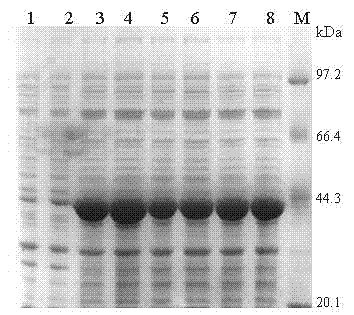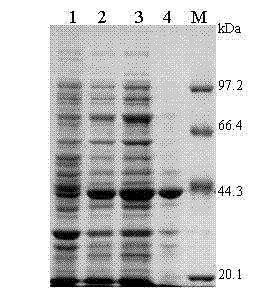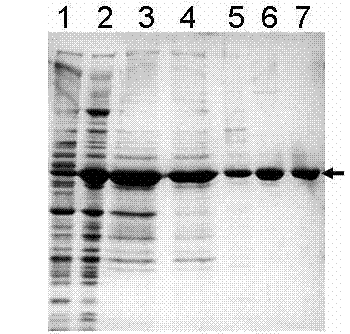Gastric cancer targeted recombinant toxin and preparation method thereof
A gastric cancer, targeted technology, applied in recombinant DNA technology, chemical instruments and methods, drug combinations, etc., can solve problems such as large side effects, limited application of DT, and damage to the patient's immune system.
- Summary
- Abstract
- Description
- Claims
- Application Information
AI Technical Summary
Problems solved by technology
Method used
Image
Examples
Embodiment 1
[0039] Example 1 Construction of a recombinant strain highly expressing the recombinant toxin of the present invention (hereinafter referred to as rG7PE38)
[0040] Comparison and analysis of existing PEA toxin sequences published by GenBank: U78761, RFT5 (scFv) ETA immunotoxin gene sequence; AY585869, H22 (scFv) PE40 recombinant toxin gene sequence; K01397, Pseudomonas aeruginosa exotoxin A gene; EU595736 green Pseudomonas aeruginosa PACS458 strain gene; EU595734, Pseudomonas aeruginosa PACS181 strain gene; CP002496, Pseudomonas aeruginosa M18 strain gene; AE004091, Pseudomonas aeruginosa PAO1 strain gene; AP012280, Pseudomonas aeruginosa NCGM2 strain S1 gene; FM209186, Pseudomonas aeruginosa LESB58 strain Gene: CP000438, gene of Pseudomonas aeruginosa UCBPP-PA14 strain; according to the comparison result and the sequence optimized by Jcat software, artificial gene synthesis is carried out, and its nucleotide sequence is as described in SEQ No.2.
[0041] The artificial g...
Embodiment 2
[0042] Example 2 Expression condition optimization
[0043] (1) Optimization of induction temperature
[0044] Inoculate the Rosetta (DE3) (pET-rG17PE38) bacterial solution that was shaken overnight into 5ml LB liquid medium (containing 20μg / ml ampicillin) at 1% inoculum, and cultivate to OD at 160rpm at 37°C 600 was 0.4, added isopropyl-β-D-thiogalactopyranoside (IPTG) with a final concentration of 1.0 mM, and continued at 180 rpm at 20°C, 25°C, 30°C, 37°C, and 42°C. Cultivate for 6h.
[0045] (2) Optimization of induction timing
[0046] Rosetta (DE3) (pET-rG17PE38) cultured by overnight shaking culture was inoculated into 5ml LB liquid medium (containing 20μg / ml ampicillin) with 1% concentration, and cultured at 160rpm at 37℃ for 0.5h, 1.0h, 1.5h, Isopropyl-β-D-thiogalactopyranoside (IPTG) with a final concentration of 1.0 mM was added at 2h, 2.5h, 3.0h, and 3.5h, respectively, and culture was continued at 37°C and 180rpm for 6h.
[0047] (3) Optimization of the amount...
Embodiment 3
[0050] Example 3 protein purification
[0051] (1) Ammonium sulfate concentration selection
[0052] Recombinant bacteria were induced by isopropyl-β-D-thiogalactopyranoside (IPTG), crushed by ultrasound at 300W for 5min, and centrifuged to get the supernatant; divided into 6 equal parts, and added to the final saturation of 10% and 20% respectively , 30%, 40%, 50%, 60% ammonium sulfate, mix thoroughly and centrifuge to collect the supernatant, continue to add ammonium sulfate to saturation of 20%, 30%, 40%, 50%, 60% and 70% , and the supernatant was discarded by centrifugation; protein samples were prepared after the pellet was resuspended, and analyzed by 12% SDS-PAGE. Screening for optimum ammonium sulfate concentration.
[0053] (2) Screening of hydrophobic chromatography conditions
[0054] Phenyl FF (high sub), Phenyl HP, Butyl FF, Octyl FF, etc. (purchased from General Electric Healthcare, USA), collected the eluate from each peak, and added trichloroacetic acid at a...
PUM
 Login to View More
Login to View More Abstract
Description
Claims
Application Information
 Login to View More
Login to View More - R&D
- Intellectual Property
- Life Sciences
- Materials
- Tech Scout
- Unparalleled Data Quality
- Higher Quality Content
- 60% Fewer Hallucinations
Browse by: Latest US Patents, China's latest patents, Technical Efficacy Thesaurus, Application Domain, Technology Topic, Popular Technical Reports.
© 2025 PatSnap. All rights reserved.Legal|Privacy policy|Modern Slavery Act Transparency Statement|Sitemap|About US| Contact US: help@patsnap.com



